
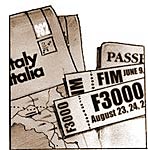
Special Edition: Le Mans Preview
Atlas F1 Magazine Writer
24 Heures Du Mans - Twice Around The Clock
Le Mans today is noticeably different from the Le Mans of yore. While in the early years there were many variations of the Le Mans circuit, by the 1920s it had settled roughly on its classic shape. Names like Ford, Dunlop, Indianapolis, Maison Blanche, and the biggest name of them all - the Mulsanne. It is a fast cricuit, a brave circuit, and it always has surprises. The ever present barriers reach out to grab you. A momentary error in the sleep-saddled hours of the morning with the dramatic closing speeds betwen the various classes of cars, from the quickest of the Audi prototypes to the slowest of the Porsche GT3s.
The strength of the Audis is obvious, from the depth of engineering, the resources available to Audi Sport North America and Joest Racing, and the strength of their driver line-ups. The two factory cars have car numbers 1 & 2, and despite the tragic loss of Michele Alboreto in testing leading up to the event, they lack for nothing. Car #1 is probably the favourite, with Frank Biela, Emanuele Pirro and Tom Kristensen on board, but Rinaldo Capello has been in hot form and leads Laurent Aiello and Christian Pescatori in the #2 car. Stefan Johansson leads car #4, his own car with Tom Coronel and occasional BAR tester Patrick Lemarie in the very familiar Gulf colours made famous around the world by Steve McQueen's Porsche 917. The #3 Champion Racing car is led by Johnny Herbert, a winner here with Mazda back in 1991, along with Ralf Kelleners and Didier Theys, the team's regular drivers. Any of the four Audis could win the race. One of them should.
Bentley however exude strength on the surface. Martin Brundle leads car #7 with regular Johansson Motorsport driver Guy Smith and Stephane Ortelli, and Andy Wallace leading Eric van de Poele and Butch Leitzinger in #8. Expect the dark green cars, the only cars entered under the LMGTP class to run hard and well, but whether they can last with minimal race testing under their belts is yet to be discovered. Subtle differences in the regulations from LMP900 to LMGTP, like fuelling for example, could bring the Bentleys undone.
Chrysler also step into the big time with ORECA leading the development of a trio of cars. In particular the #16 Playstation car of Olivier Beretta, Karl Wendlinger and Pedro Lamy looks strong, although the #15 car boasts multiple Le Mans winner Yannick Dalmas and Stephane Sarrazin. Chrysler have told ORECA they have two years to claim Le Mans. ORECA's Vipers have dominated the lower classes but the upward step to LMP900 class is steep.
Cadillac return with the strange Northstar program. Reliability is a big question mark for these cars, an odd mix of old and new, being run out of the Formula 3000 based DAMS organisation. Henri Pescarolo has also returned to Le Mans with a pair of Peugeot powered Courages with the #17 car of F3000 hotshot Sebastien Bourdais, former Sauber driver Jean-Christophe Boullion and Laurent Redon looking like a definite top ten threat, while SMG also have a Courage. There's also a pair of Japanese Dome S101s powered by the former Judd Formula One motor, with Jan Lammers leading the Dutch car and John Nielsen leading the Den Bla Avis car, and Klaus Zwart has entered two Ascaris.
In the LMGTS class, it is a clash of the Americans. The tried and tested Chrysler Vipers, against the pace of the Saleens, and the a pair of Chevy Corvettes thrown in for spice. It will be an interesting battle for the class win. The Saleens are being tended by Franz Konrad and Ray Mallock run teams, both class acts of the highest order. The Saleen is a new car however. The Vipers have been there, done that, but development has not been forthcoming recently. Interest is sparked by the presence of Vanina Ickx in one of the Paul Belmondo Vipers. The yellow Corvettes have the runs on the board this year, with an impressive run at Sebring and an outright victory at Daytona in the hands of the Gary Pratt run team. Each of the cars has its own strengths. Can the Corvettes run the Saleens into the ground and gap the Vipers sufficiently to coast home? This will be the most entertaining class in the race to watch.
There is always something interesting with Le Mans though, and as we circle the clock twice this weekend, the stories will unfold, as they always do.
![]() Le Mans
Le Mans
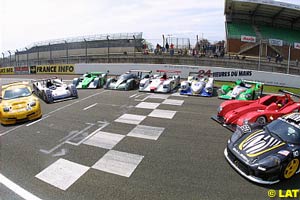 The 1970 Steve McQueen motion picture described Le Mans as 'The Grand Prix of Speed and Endurance'. Even today, as sprint races get longer, and the endurance races are run harder each year, this is still very much the case at Le Mans. Today, Le Mans is one of a select few fabled circuits, giants in myth, rich in history and with an honour roll the equal of any circuit in the world. Circuits like Belgium's Spa-Francorchamps, which even though substantially rebuilt in the 1980s still retains the grandeur of its former guise that extended out through Malmedy and Masta. Circuits like Italy's Monza, the cathedral of motor racing, immortalised forever in the film 'Grand Prix', the huge banking extending out into the trees. Like Indianapolis Motor Speedway in the USA, the original and still the definitive Superspeedway, home to the world's oldest race. Like Germany's Nurburgring Nordschleife, all 170 plus corners, the best test of a driver's ability ever devised in the history of the sport. Like Australia's Mount Panorama, a strange combination of Spa, Silverstone and Nurburgring, but with an identity uniquely its own.
The 1970 Steve McQueen motion picture described Le Mans as 'The Grand Prix of Speed and Endurance'. Even today, as sprint races get longer, and the endurance races are run harder each year, this is still very much the case at Le Mans. Today, Le Mans is one of a select few fabled circuits, giants in myth, rich in history and with an honour roll the equal of any circuit in the world. Circuits like Belgium's Spa-Francorchamps, which even though substantially rebuilt in the 1980s still retains the grandeur of its former guise that extended out through Malmedy and Masta. Circuits like Italy's Monza, the cathedral of motor racing, immortalised forever in the film 'Grand Prix', the huge banking extending out into the trees. Like Indianapolis Motor Speedway in the USA, the original and still the definitive Superspeedway, home to the world's oldest race. Like Germany's Nurburgring Nordschleife, all 170 plus corners, the best test of a driver's ability ever devised in the history of the sport. Like Australia's Mount Panorama, a strange combination of Spa, Silverstone and Nurburgring, but with an identity uniquely its own.
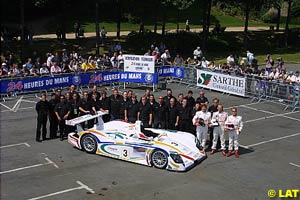 This year's field features quite a few big names. A swag of manufacturers putting into the event this year, including the historic returns of Bentley and MG, the big dollar attacks from Cadillac and Chrysler, the presence of familiar names like Panoz and Courage, plus oddities like the Domes and the Ascaris. The prototype field is dominated though by the presence of Audi. Two factory cars and two supported private entires, these cars could very easily finish first to fourth. In the ALMS and the ELMS series, the Audis have been that far clear of the competition it has almost been ridiculous. Panoz are having trouble sorting the new LMP07, and even when running well it's just not on the same pace as the Audis. Of the others, they are slower, short of funds, or in more than a few cases, testing away from the public gaze, hoping to maximise their publicity at Le Mans, and perhaps minimise their losses should the Audis disappear into the distance.
This year's field features quite a few big names. A swag of manufacturers putting into the event this year, including the historic returns of Bentley and MG, the big dollar attacks from Cadillac and Chrysler, the presence of familiar names like Panoz and Courage, plus oddities like the Domes and the Ascaris. The prototype field is dominated though by the presence of Audi. Two factory cars and two supported private entires, these cars could very easily finish first to fourth. In the ALMS and the ELMS series, the Audis have been that far clear of the competition it has almost been ridiculous. Panoz are having trouble sorting the new LMP07, and even when running well it's just not on the same pace as the Audis. Of the others, they are slower, short of funds, or in more than a few cases, testing away from the public gaze, hoping to maximise their publicity at Le Mans, and perhaps minimise their losses should the Audis disappear into the distance.
 Of the rest, the favourites are probably the Bentley and Panoz teams. Panoz has the runs on the board, but a suspect car. David Brabham and Jan Magnussen have formed a fearsome combination in sports car racing and will be one to watch if the #12 Panoz they share with Franck Lagorce lasts. Klaus Graf is joined by Jamie Davies and Gary Formato in the #11 Panoz.
Of the rest, the favourites are probably the Bentley and Panoz teams. Panoz has the runs on the board, but a suspect car. David Brabham and Jan Magnussen have formed a fearsome combination in sports car racing and will be one to watch if the #12 Panoz they share with Franck Lagorce lasts. Klaus Graf is joined by Jamie Davies and Gary Formato in the #11 Panoz.
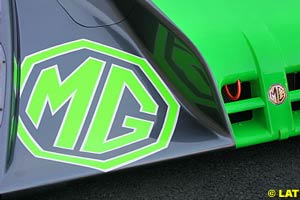 Under the engine regulations, the high profile MG team is a LMP675 team. It is thought the lurid black and lime cars won't have the outright pace of the LMP900 cars, but with drivers like Mark Blundell, Julian Bailey, Anthony Reid and Jonny Kane on board, they'll be driven quickly without a doubt. The team and cars though are complete unknowns. How they'll fare against the Pilbeam, the Knight Hawk Lola-Nissan, the well-staffed Dick Barbour Reynard-Zytek cars and the ROC Reynard-Volkswagens will be a developing question as the race wears on. The lone Pilbeam M484 Nissan from the S+R Rowan Racing team is well prepared and driven, and as a naturally aspirated car has a reliability edge over its turbo-powered class mates, definitely a car to watch. The #36 Reynard-Zytek from the Dick Barbour team has its engine, the heart of Formula 3000 racing, as a positive, and a fair driver combination in Didier de Radigues, Sascha Maassen and Hideshi Matsuda.
Under the engine regulations, the high profile MG team is a LMP675 team. It is thought the lurid black and lime cars won't have the outright pace of the LMP900 cars, but with drivers like Mark Blundell, Julian Bailey, Anthony Reid and Jonny Kane on board, they'll be driven quickly without a doubt. The team and cars though are complete unknowns. How they'll fare against the Pilbeam, the Knight Hawk Lola-Nissan, the well-staffed Dick Barbour Reynard-Zytek cars and the ROC Reynard-Volkswagens will be a developing question as the race wears on. The lone Pilbeam M484 Nissan from the S+R Rowan Racing team is well prepared and driven, and as a naturally aspirated car has a reliability edge over its turbo-powered class mates, definitely a car to watch. The #36 Reynard-Zytek from the Dick Barbour team has its engine, the heart of Formula 3000 racing, as a positive, and a fair driver combination in Didier de Radigues, Sascha Maassen and Hideshi Matsuda.
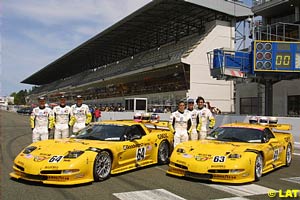 In the LMGT category, it is wall to wall Porsches. 996 GT3s fill the entry apart from a lone orphaned Callaway C-12R. Amongst the Porsches there is the usual mix of well prepared drivers and cars from teams of varying levels of budget and driver ability, from Italy, France, Germany and Japan. With Dick Barbour and Franz Konrad running elsewhere, a lot of quality is missing from GT. Watch for the Larbre #80 car, the Taisan #72 car and the #82 Seikel car. But it's still a lottery.
In the LMGT category, it is wall to wall Porsches. 996 GT3s fill the entry apart from a lone orphaned Callaway C-12R. Amongst the Porsches there is the usual mix of well prepared drivers and cars from teams of varying levels of budget and driver ability, from Italy, France, Germany and Japan. With Dick Barbour and Franz Konrad running elsewhere, a lot of quality is missing from GT. Watch for the Larbre #80 car, the Taisan #72 car and the #82 Seikel car. But it's still a lottery.
Please Contact Us for permission to republish this or any other material from Atlas F1.
|
Volume 7, Issue 24
Atlas F1 Exclusive
Interview with Trulli
BMW-Williams-Michelin Q & A
Atlas F1 Special
Team Connaught Part II: Remembrance of Things Fast
Canadian GP Review
The Canadian GP Review
Reflections from Montreal
The Strongest Virtue
Fishing for Future Designers
Columns
Elsewhere in Racing Special Edition: Le Mans Preview
The F1 Insider
Season Strokes - the GP Cartoon
Qualifying Differentials
The Weekly Grapevine
> Homepage |